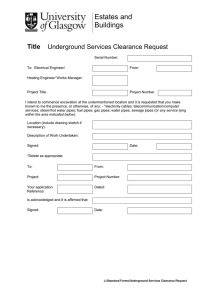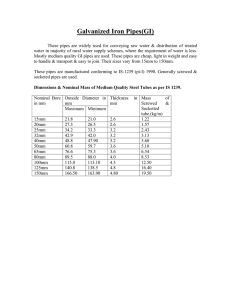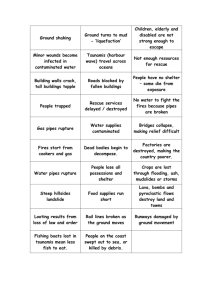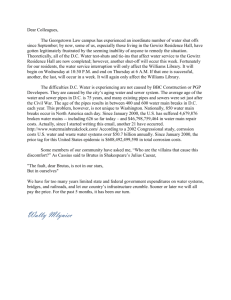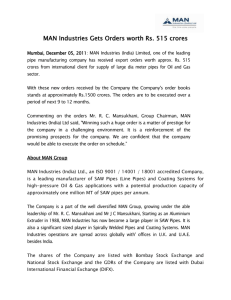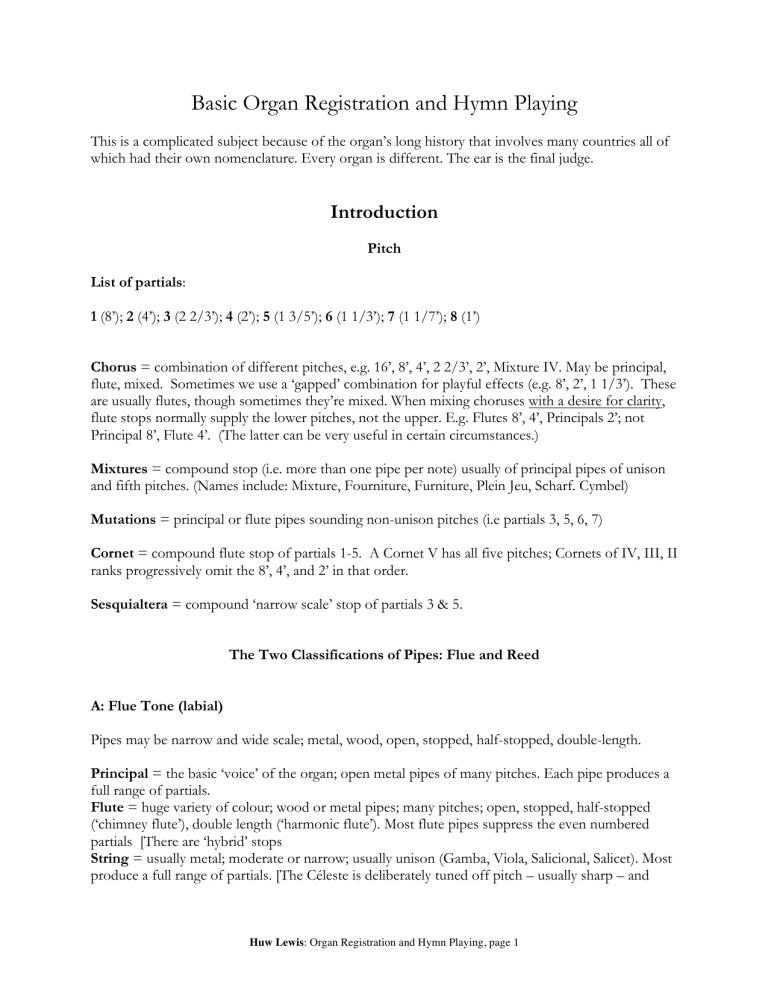
Basic Organ Registration and Hymn Playing This is a complicated subject because of the organ’s long history that involves many countries all of which had their own nomenclature. Every organ is different. The ear is the final judge. Introduction Pitch List of partials: 1 (8’); 2 (4’); 3 (2 2/3’); 4 (2’); 5 (1 3/5’); 6 (1 1/3’); 7 (1 1/7’); 8 (1’) Chorus = combination of different pitches, e.g. 16’, 8’, 4’, 2 2/3’, 2’, Mixture IV. May be principal, flute, mixed. Sometimes we use a ‘gapped’ combination for playful effects (e.g. 8’, 2’, 1 1/3’). These are usually flutes, though sometimes they’re mixed. When mixing choruses with a desire for clarity, flute stops normally supply the lower pitches, not the upper. E.g. Flutes 8’, 4’, Principals 2’; not Principal 8’, Flute 4’. (The latter can be very useful in certain circumstances.) Mixtures = compound stop (i.e. more than one pipe per note) usually of principal pipes of unison and fifth pitches. (Names include: Mixture, Fourniture, Furniture, Plein Jeu, Scharf. Cymbel) Mutations = principal or flute pipes sounding non-unison pitches (i.e partials 3, 5, 6, 7) Cornet = compound flute stop of partials 1-5. A Cornet V has all five pitches; Cornets of IV, III, II ranks progressively omit the 8’, 4’, and 2’ in that order. Sesquialtera = compound ‘narrow scale’ stop of partials 3 & 5. The Two Classifications of Pipes: Flue and Reed A: Flue Tone (labial) Pipes may be narrow and wide scale; metal, wood, open, stopped, half-stopped, double-length. Principal = the basic ‘voice’ of the organ; open metal pipes of many pitches. Each pipe produces a full range of partials. Flute = huge variety of colour; wood or metal pipes; many pitches; open, stopped, half-stopped (‘chimney flute’), double length (‘harmonic flute’). Most flute pipes suppress the even numbered partials [There are ‘hybrid’ stops String = usually metal; moderate or narrow; usually unison (Gamba, Viola, Salicional, Salicet). Most produce a full range of partials. [The Céleste is deliberately tuned off pitch – usually sharp – and Huw Lewis: Organ Registration and Hymn Playing, page 1 combined with another stop to create beats: the Italian 17th Century Voce Umana was a gentle principal celeste stop – imitating the human voice.] B: Reed Tone (lingual) Vast variety of types and colours for solo and ‘chorus’ use, with or without flues, some imitating wind instruments from the Renaissance to the Romantic periods. A solo Tuba (very ‘round’ tone) can stand up against the full organ; a Trompette en Chamade has its pipes positioned horizontally and is very sharp and brilliant. Conical ‘full length’ reeds include: Trumpet, Clarion, Bombarde, Trombone, Fagott, Schalmei, Oboe. Cylindrical ‘half length’ reeds include: Dulzian, Cromorne, Krummhorn, Rohrschalmei. Short (‘fractional’) length reeds include: Vox Humana, Regal, Sordun, Bärpfeife, Rankett Setting Up the Organ The most useful thing to do is to set up the organ so that one can move gradually from very soft to very loud – using the divisional pistons as much as possible, rather than the general pistons. 1. 2. 3. 4. 5. 6. 7. 8. Carefully evaluate the carrying power of your instrument versus the carrying power of those you are accompanying. Carefully assess the carrying quality of the unenclosed stops. Be especially careful of the (unenclosed) higher pitches. Try to support the choir from below (for example, by putting the R.H. on quieter manual). Be sparing in the use of celeste stops, and generally avoid a flat tuned céleste until after the singing has ended… Seize opportunities for soloing lines. Be careful of using powerful 8' reeds while the choir is singing. Work out a ‘standard’ service playing piston set-up that allows for easy crescendos and diminuendos using divisional pistons only if possible. Keep careful records of accompaniments for anthems etc. A suggested 'build up' on the Swell division might be: String 8' + Flute 8' + Flute 4' + Diapason 8' + [+ Oboe 8' ] Diapason 4' + [Principal 2'] + Oboe 8' + [Principal 2'] + Low Mixture + Reed 16' + [Higher Mixture] + Reed 8' + [Higher Mixture] + Reed 4' Huw Lewis: Organ Registration and Hymn Playing, page 2 DIMNENT MEMORIAL CHAPEL HOPE COLLEGE HOLLAND, MICHIGAN The Chancel Organ Built by the E. M. Skinner Organ Company of Boston, Massachusetts The main organ in the front of Dimnent Chapel was built in 1929. It contains forty-eight ranks of pipes making a total of 2,932 pipes in all. These are distributed over six divisions which are controlled by a console with four manuals and a pedal keyboard. The longest pipe is 16 feet long and about 16 inches square; the smallest pipe is about one-half inch long. The organ also has two percussion stops: a set of chimes and a mechanical harp. In 1963 it was cleaned, refurbished, re-leathered and regulated. The Great, Choir and Pedal divisions are located in the chambers to the left, the Swell division is located in the chamber to the right and the Solo division is located in a chamber above the proscenium arch. The Echo section and the chimes are located in a chamber which opens in the southwest corner of the gallery. The action of the organ is electro-pneumatic, and wind pressures range from 5 to 15 inches. Several of the divisions reflect the goals of organ builders from the American Romantic period of the early 1900’s, and boast numerous 8 foot (unison) stops. Such stops are intended rather to imitate instruments of the symphony orchestra than to function as members of the classic organ ensemble. Complete diapason and reed choruses are to be found on the Great and Swell divisions, however: these two divisions provide the full traditional ensemble of the instrument. SPECIFICATIONS The organ has a total of 8 unison, 12 octave, and 6 pedal couplers. There are 4 adjustable general combinations pistons affecting all stops; 6 combination pistons for the Great, Choir, Solo/Echo, and Pedal divisions, and 8 for the Swell division. Great Organ Bourdon (Pedal extension) First Diapason Second Diapason Flute Harmonique Principal Flute Fifteenth Mixture IV ranks Tuba Clarion 16' 8' 8' 8' 4' 4' 2' 2' 8' 4' 17 pipes 61 pipes 61 pipes 61 pipes 61 pipes 61 pipes 61 pipes 244 pipes 61 pipes 61 pipes Swell Organ (under expression) Diapason 8' Rohrfloete 8' Flauto Dolce 8' Flute Celeste 8' Salicional 8' Voix Celeste 8' Octave 4' Flute Triangulaire 4' Mixture V ranks 2' Waldhorn 16' Trumpet 8' Oboe 8' Vox Humana 8' Clarion 4' Tremolo 73 pipes 73 pipes 73 pipes 61 pipes 73 pipes 73 pipes 73 pipes 73 pipes 305 pipes 73 pipes 73 pipes 73 pipes 73 pipes 73 pipes Choir Organ (under expression) Geigen 8' Concert Flute 8' Dulciana 8' Unda Maris 8' Flute 4' Nazard English Horn 22/3' 8' Harp Celesta Tremolo 8' 4' 61 bars and resonators Solo Organ (under expression) Gamba 8' Gamba Celeste 8' French Horn 8' Tuba Mirabilis 8' Tremolo 73 pipes 73 pipes 73 pipes 73 pipes Echo Organ (under expression) Diapason 8' Fernfloete 8' Vox Humana 8' Tromba 8' Chimes Tremolo 73 pipes 73 pipes 73 pipes 73 pipes 25 tubular bells Pedal Diapason Diapason Bourdon Octave Gedeckt Flute Trombone Tromba Clarion 73 pipes 73 pipes 73 pipes 61 pipes 73 pipes 61 pipes 73 pipes Huw Lewis: Organ Registration and Hymn Playing, page 3 32' 16' 16' 8' 8' 4' 16' 8' 4' (Lower 12 resultant) 32 pipes 32 pipes 12 pipes 12 pipes 12 pipes 32 pipes 12 pipes 12 pipes DIMNENT CHAPEL PISTON SETTINGS FOR SERVICE PLAYING Solo #1 = Flute 8' #2 = #1 + Vox Humana 8' #3 = Cel. 8' #4 = Diap. 8' #5 = #4 #6 = #5 + Tuba 8' + Trumpet 8' Swell #1 = Voix Celestes 8' #2 = Salic.8 & Rohr Flute 8 #3 = #2 + Flute 4' #4 = #3 #5 = #4 #6 = #5 + Mixture #7 = #6 #8 = #7 + Diapason 8’ + Octave 4’ + Oboe 8’ + Waldhorn 16 + Trumpet 8’ + Clarion 4’ Great Choir Pedal #1 = Flute 8' + Flute 4' #1 = Unda Maris & Dul. #1 = Bourdon 16’ #2 = #1 #3 = #2 #4 = #3 #5 = #4 #6 = #5 + 2nd. Diap. 8 + 1st. Diap. 8’ + Principal 4’ + Bourdon 16' + Mixture + Fifteenth 2’ + Trumpet 8' #5 = Fl. 8' & 4' + Nazard #6 = English Horn #2 = Dulciana #3 = #2 #4 = #3 + Melodia 8’ + Flute 4’ + Geigen 8’ #2 = #1 #3 = #2 #4 = #3 #5 = #4 #6 = #5 + Gedeckt’ + Diapason 16' + Octave 8’ + Diapason 32' + Trombone 16' + Flute (4') . Gen. #1 So: #2 Sw: Flute Celestes 8' Gt: Flute 8' Ch: English Horn Ped: #1 Sw/Ped 8' Sw/Gt 8' Gen. #2 So: #4 Sw: #4 Gt: #2 Ch: #4 Ped: #2 Sw, Gt, Ch, So/Ped 8' Sw, Ch, So/Gt 8', Sw/Ch 8' Gen. #3 So: #4 Sw: #6 Gt: #4 Ch: #4 Ped: #3 Sw, Gt, Ch, So/Ped 8' Sw, Ch, So/Gt 8'; Sw/Ch 8' So/Gt 4' Gen. #4 So: #6 Sw: #8 Gt: #6 Ch: #4 Ped: #6 Sw, Gt, Ch, So/Ped 8' Sw, Ch, So/Gt 8'; So/Gt 16' Sw/Ch 8' & 4' + Clarion 4' + Tromba 8' Huw Lewis: Organ Registration and Hymn Playing, page 4 Guidelines for Hymns Accompaniment Articulation (tied notes etc.) As a general rule: • Play legato – especially in dry acoustics; • Tie common-tones, but repeat before strong beats; • Don't tie repeated melody notes: 1. 2. 3. 4. 5. Play the tune while singing it. Practice the pedal part alone (sing the tune while playing the pedal part!). Play the tune with the pedal. Avoid doubling the pedal part with the left hand. Carefully work out the distribution of the manual parts between the hands, and add in the fingering and points of articulation. 6. Clearly set the mood of the hymn through the tempo, dynamics, and touch. 7. Establish a consistent pattern of rests between the verses, and keep it consistent for the duration of the hymn if there are to be no interludes. This can help congregational confidence. (If you use interludes, make it clear to the congregation by starting the interlude on the last word of the stanza: if you modulate in major keys, remember that minor IV is very helpful..) The introduction may be simple or complex. 1. Play the hymn all the way through, with or without pedals. 2. In some hymns (in some situations), omit selected interior phrases. 3. Alternate the tune in octaves with harmony, phrase by phrase; the octaves may be played on a loud solo stop. 4. Add parts incrementally (i.e., start with a solo line—pedals?—add one voice per phrase. 5. Solo out the tune with the right hand. A strong Cornet can be very nice for this. (Note: this often takes practice and is not so easy for most beginning organists.) Try introducing the hymn in the tenor range; 6. Introduce the hymn over a musette figure. 7. More elaborate introductions may be selected from composed collections, or improvised (i.e. worked out beforehand!). Registration 1. The first stops to draw are: Swell to Great; Swell to Pedal; and Great to Pedal. 2. The Diapasons are the 'bread-and-butter' stops of hymn playing. A good Diapason at 8' pitch (unison) should be scaled and voiced to accompany a congregation in a prayerful hymn—unless the building is very, very large. 3. The Diapason chorus (8', 4', 2', with or without mixture) is the basis for most hymn accompaniments. Huw Lewis: Organ Registration and Hymn Playing, page 5 4. Flutes are used if they are full-bodied, the hymn is very quiet, and the congregation is small. 5. Strings are rarely used for hymn accompaniment: they are usually too soft. They can be very effective, however, if the congregation is a 'singing congregation' or if there is a good choir that will lead the congregation in quiet hymns. They are used for very quiet verses, and for fading out organ accompaniment where unaccompanied hymn singing is desired and possible. 6. Reeds may be added to the Diapason chorus for fiery, and dramatic effects. A 16' reed is often more effective than an 8' reed. 7. Some traditions tend to discourage the use of 16' manual tone, while others encourage it. It is a matter of 'local taste.' 8. Plan the registration beforehand, and allow it to be varied. While Diapasons 8' 4', 2' are an effective way to lead a congregation, they can become tiresome. Do not be afraid to use 16’ manual tone, as well as reed tone at 16’ pitch. 9. However, in planning registration, avoid excessively dramatic changes — these may be more gradually introduced by interludes. Tempo/Phrasing 1. Establish a natural, easy tempo before you start the introduction. If you sing ‘in your mind’ imagine singing loudly with deep breaths. 2. Imagining fewer but larger beats can help with musical flexibility. 3. The 'larger' the beat, the easier it is to project the musical line, which in turn will the literary (spiritual) thought being expressed. The character of the text, the length of the musical phrase, the number of singers, the size of the space, the nature of the church’s acoustics, and, finally, local tradition (not to be underestimated) will play important roles in determining tempo. 4. Generally, the bigger, the broader. 5. Speed does not necessarily generate excitement: nor does slow guarantee expressiveness. 6. A living, flexible rhythm is paramount. 7. Do not be afraid to be flexible with the tempo: indeed, a slight broadening of the tempo of the final verse can be very powerful. Varying the hymn accompaniment. 1. Less is usually more: never draw too much attention to the organ. 2. Pedal points, especially in the last phrase. 3. Descants created from either the alto or tenor voices (when you are practiced at this, you end up combining these voices). 4. Passing tones, especially between thirds (this is a simple diminution technique). 5. Simple re-harmonization of internal main cadences. Huw Lewis: Organ Registration and Hymn Playing, page 6 Quiet Solo Combinations All of the folowingcan be used with or without the Tremulant. The accompaniment can be a simple 8’ flute (possibly with a 4’)’ in the manual, and a quiet 16’ in the pedal coupled to the accompaniment manual. 8’ Principal (or 4’ played octave below). 8’ Oboe (sometimes a 16’ reed played 8ve higher, or a 4’ reed played 8 ve lower. Cromorne, with or without flute 8’ or 4’. Flutes 8’, 4’, 2 2/3’. Flutes 8’, 4’, 1 3/5. Flutes 8’, 2 2/3, 1 3/5’. Huw Lewis: Organ Registration and Hymn Playing, page 7
